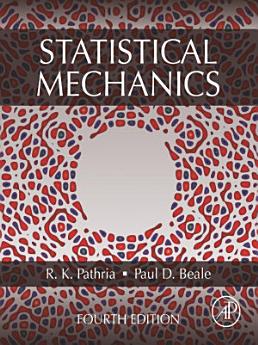Statistical Mechanics: Edition 4
R.K. Pathria · Paul D. Beale
មីនា 2021 · Academic Press
សៀវភៅអេឡិចត្រូនិច
768
ទំព័រ
family_home
មានសិទ្ធិ
info
reportការវាយតម្លៃ និងមតិវាយតម្លៃមិនត្រូវបានផ្ទៀងផ្ទាត់ទេ ស្វែងយល់បន្ថែម
អំពីសៀវភៅអេឡិចត្រូនិកនេះ
Statistical Mechanics, Fourth Edition, explores the physical properties of matter based on the dynamic behavior of its microscopic constituents. This valuable textbook introduces the reader to the historical context of the subject before delving deeper into chapters about thermodynamics, ensemble theory, simple gases theory, Ideal Bose and Fermi systems, statistical mechanics of interacting systems, phase transitions, and computer simulations. In the latest revision, the book's authors have updated the content throughout, including new coverage on biophysical applications, updated exercises, and computer simulations. This updated edition will be an indispensable to students and researchers of statistical mechanics, thermodynamics, and physics. - Retains the valuable organization and trusted coverage of previous market-leading editions - Includes new coverage on biophysical applications and computer simulations - Offers Mathematica files for student use and a secure solutions manual for qualified instructors - Covers Bose-Einstein condensation in atomic gases, Thermodynamics of the early universe, Computer simulations: Monte Carlo and molecular dynamics, Correlation functions and scattering, Fluctuation-dissipation theorem and the dynamical structure factor, and much more
អំពីអ្នកនិពន្ធ
Professor Raj Kumar Pathria is a theoretical physicist and an Urdu poet. He is known for his work on superfluidity in liquid helium, Lorentz transformation of thermodynamic quantities, a rigorous evaluation of lattice sums, and finite-size effects in phase transitions. Pathria obtained his BSc Honours degree in 1953 and MSc Honours degree in 1954 from Panjab University, Hoshiarpur, and earned a Ph.D. in Physics from University of Delhi in 1957. He has served on the physics faculties of the University of Delhi (1958-1964), McMaster University (1964-1965), University of Alberta (1965-1967), Panjab University, Chandigarh (1967-1969), and the University of Waterloo (1969-1998). After retirement, he moved to California to be close to family, and joined the faculty of the University of California San Diego as an adjunct professor of physics in 2000. The University of Waterloo honored him with both the Distinguished Teacher Award and the title Distinguished Professor Emeritus, and he is a Fellow of the American Physical Society. Raj is the author of over one-hundred published papers and two textbooks. The Theory of Relativity was first published in 1963 by Hindustan Publishing, with the second edition published by Pergamon Press, Oxford. This latter edition was republished by Dover Press in 2003. His widely used graduate physics textbook Statistical Mechanics is now in its fourth edition. It was originally published by Pergamon Press in 1974, with the second through fourth editions published by Elsevier in 1996, 2011, and 2021. Paul Beale joined Raj as coauthor of the third edition and fourth editions. Raj was nurtured in an atmosphere of Urdu language, idiom, and poetry. He published a compilation of his Urdu poems in Saihraa Saihraa, published under the pseudonym Raj Kumar Qais. The title means 'desert after desert' after the unending wanderings of Qais, the fabled lover of the Arabian damsel Laila. Raj is married to Raj Kumari Pathria. They have three children and five grandchildren.Paul D. Beale is a Professor of Physics at the University of Colorado Boulder. He earned a B.S. in Physics with Highest Honors at the University of North Carolina Chapel Hill in 1977, and Ph.D. in Physics from Cornell University in 1982. He served as a postdoctoral research associate at the Department of Theoretical Physics at Oxford University from 1982-1984. He joined the faculty of the University of Colorado Boulder in 1984 as an assistant professor, was promoted to associate professor in 1991, and professor in 1997. He served as the Chair of the Department of Physics from 2008-2016. He also served as Associate Dean for Natural Sciences in the College of Arts and Sciences, and Director of the Honors Program. He is currently Director of the Buffalo Bicycle Classic, the largest scholarship fundraising event in the State of Colorado. Beale is a theoretical physicist specializing in statistical mechanics, with emphasis on phase transitions and critical phenomena. His work includes renormalization group methods, finite-size scaling in spin models, fracture modes in random materials, dielectric breakdown in metal-loaded dielectrics, ferroelectric switching dynamics, exact solutions of the finite two-dimensional Ising model, solid-liquid phase transitions of molecular systems, and ordering in layers of molecular dipoles. His current interests include scalable parallel pseudorandom number generators, and interfacing quantum randomness with cryptographically secure pseudorandom number generators. He is coauthor with Raj Pathria of the third and fourth editions of the graduate physics textbook Statistical Mechanics. The Boulder Faculty Assembly has honored him with the Excellence in Teaching and Pedagogy Award, and the Excellence in Service and Leadership Award. Beale is a private pilot and an avid cyclist. He is married to Erika Gulyas, and has two children: Matthew and Melanie.
វាយតម្លៃសៀវភៅអេឡិចត្រូនិកនេះ
ប្រាប់យើងអំពីការយល់ឃើញរបស់អ្នក។
អានព័ត៌មាន
ទូរសព្ទឆ្លាតវៃ និងថេប្លេត
ដំឡើងកម្មវិធី Google Play Books សម្រាប់ Android និង iPad/iPhone ។ វាធ្វើសមកាលកម្មដោយស្វ័យប្រវត្តិជាមួយគណនីរបស់អ្នក និងអនុញ្ញាតឱ្យអ្នកអានពេលមានអ៊ីនធឺណិត ឬគ្មានអ៊ីនធឺណិតនៅគ្រប់ទីកន្លែង។
កុំព្យូទ័រយួរដៃ និងកុំព្យូទ័រ
អ្នកអាចស្ដាប់សៀវភៅជាសំឡេងដែលបានទិញនៅក្នុង Google Play ដោយប្រើកម្មវិធីរុករកតាមអ៊ីនធឺណិតក្នុងកុំព្យូទ័ររបស់អ្នក។
eReaders និងឧបករណ៍ផ្សេងទៀត
ដើម្បីអាននៅលើឧបករណ៍ e-ink ដូចជាឧបករណ៍អានសៀវភៅអេឡិចត្រូនិក Kobo អ្នកនឹងត្រូវទាញយកឯកសារ ហើយផ្ទេរវាទៅឧបករណ៍របស់អ្នក។ សូមអនុវត្តតាមការណែនាំលម្អិតរបស់មជ្ឈមណ្ឌលជំនួយ ដើម្បីផ្ទេរឯកសារទៅឧបករណ៍អានសៀវភៅអេឡិចត្រូនិកដែលស្គាល់។






